LTAD Program: Developing a Young Athlete for Olympic Success
VerifiedAdded on 2023/04/21
|14
|1573
|171
Case Study
AI Summary
This case study examines the Long-Term Athlete Development (LTAD) program for a 6-year-old boy with Olympic aspirations. It details the ten factors influencing the LTAD program, including fundamentals, specialization, developmental age, trainability, and physical, mental, cognitive, and emotional development. The study outlines the seven stages of the LTAD training plan, from the Active Start phase to the Train to Compete stage, emphasizing skill development, physical growth, and appropriate training intensity. The document also addresses the importance of nutrition, providing guidelines on carbohydrate and protein intake, as well as health and wellness considerations. Furthermore, it explores the anatomy of a basketball player, highlighting the significance of height, lean build, and other physical attributes. The case study references various sources and provides insights into the holistic approach required for long-term athletic success. This document offers valuable information for anyone interested in athletic development, sports science, and the principles of LTAD.
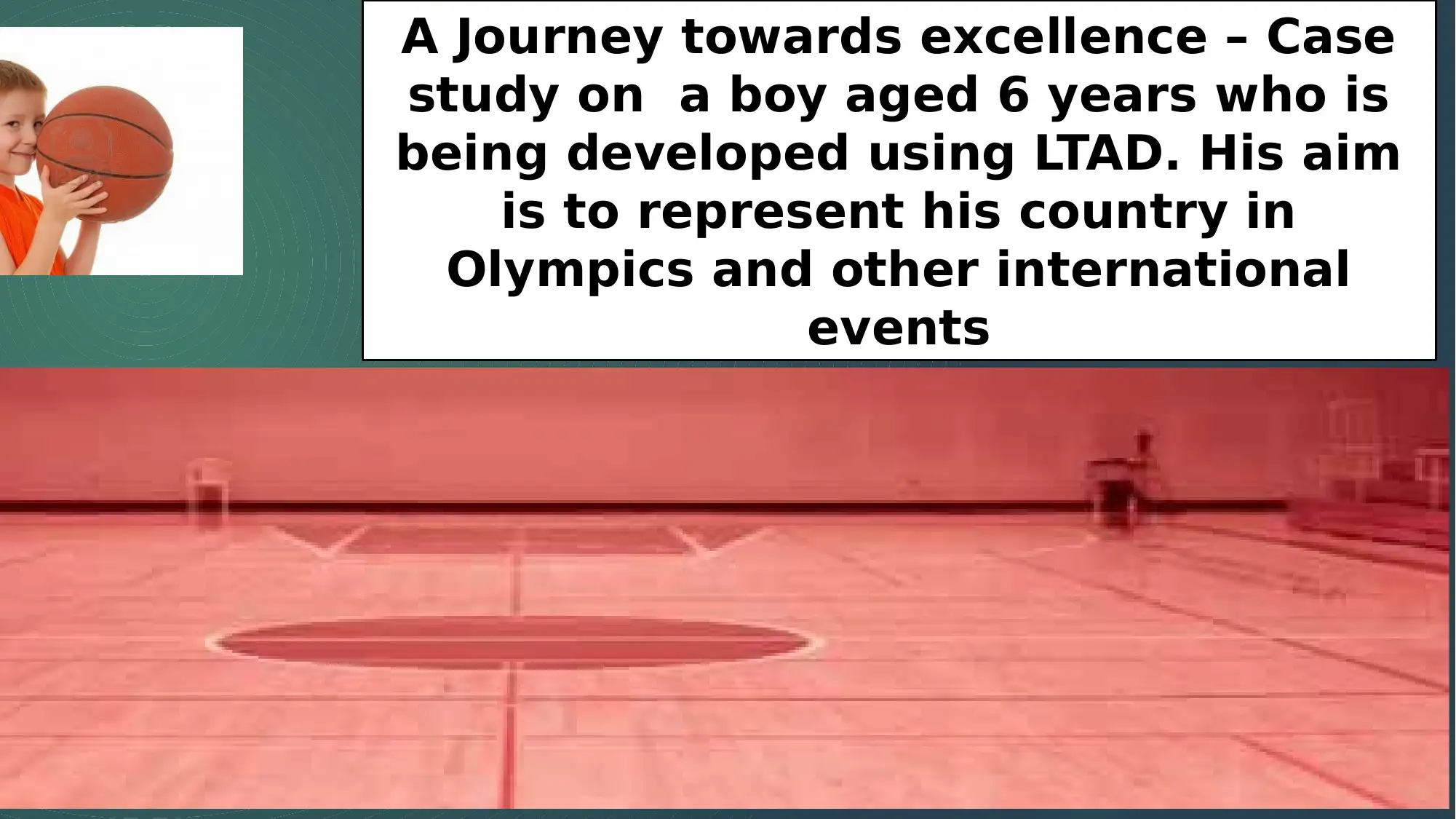
A Journey towards excellence – Case
study on a boy aged 6 years who is
being developed using LTAD. His aim
is to represent his country in
Olympics and other international
events
study on a boy aged 6 years who is
being developed using LTAD. His aim
is to represent his country in
Olympics and other international
events
Paraphrase This Document
Need a fresh take? Get an instant paraphrase of this document with our AI Paraphraser
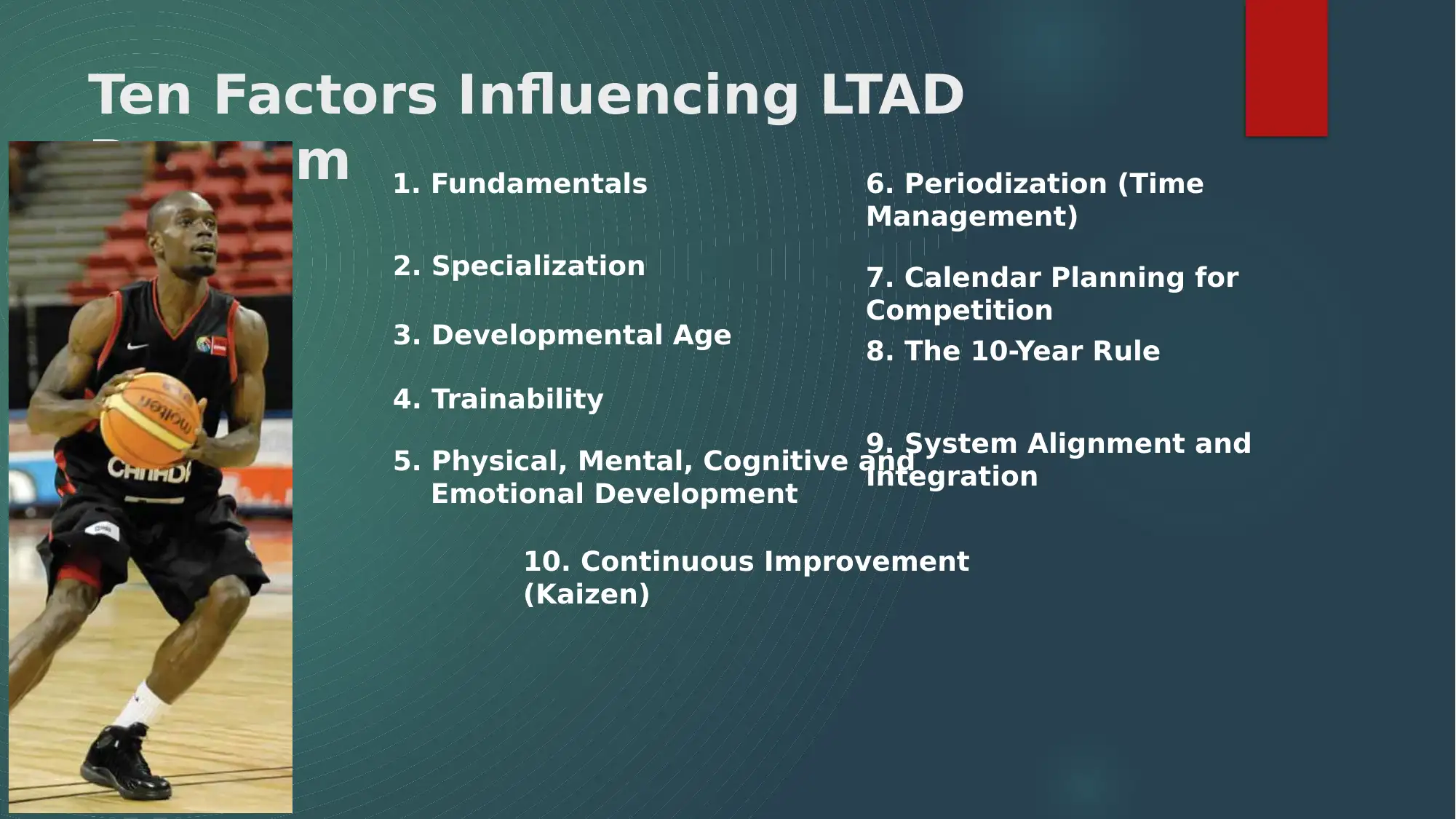
Ten Factors Influencing LTAD
Program 1. Fundamentals
2. Specialization
3. Developmental Age
4. Trainability
5. Physical, Mental, Cognitive and
Emotional Development
6. Periodization (Time
Management)
7. Calendar Planning for
Competition
8. The 10-Year Rule
9. System Alignment and
Integration
10. Continuous Improvement
(Kaizen)
Program 1. Fundamentals
2. Specialization
3. Developmental Age
4. Trainability
5. Physical, Mental, Cognitive and
Emotional Development
6. Periodization (Time
Management)
7. Calendar Planning for
Competition
8. The 10-Year Rule
9. System Alignment and
Integration
10. Continuous Improvement
(Kaizen)
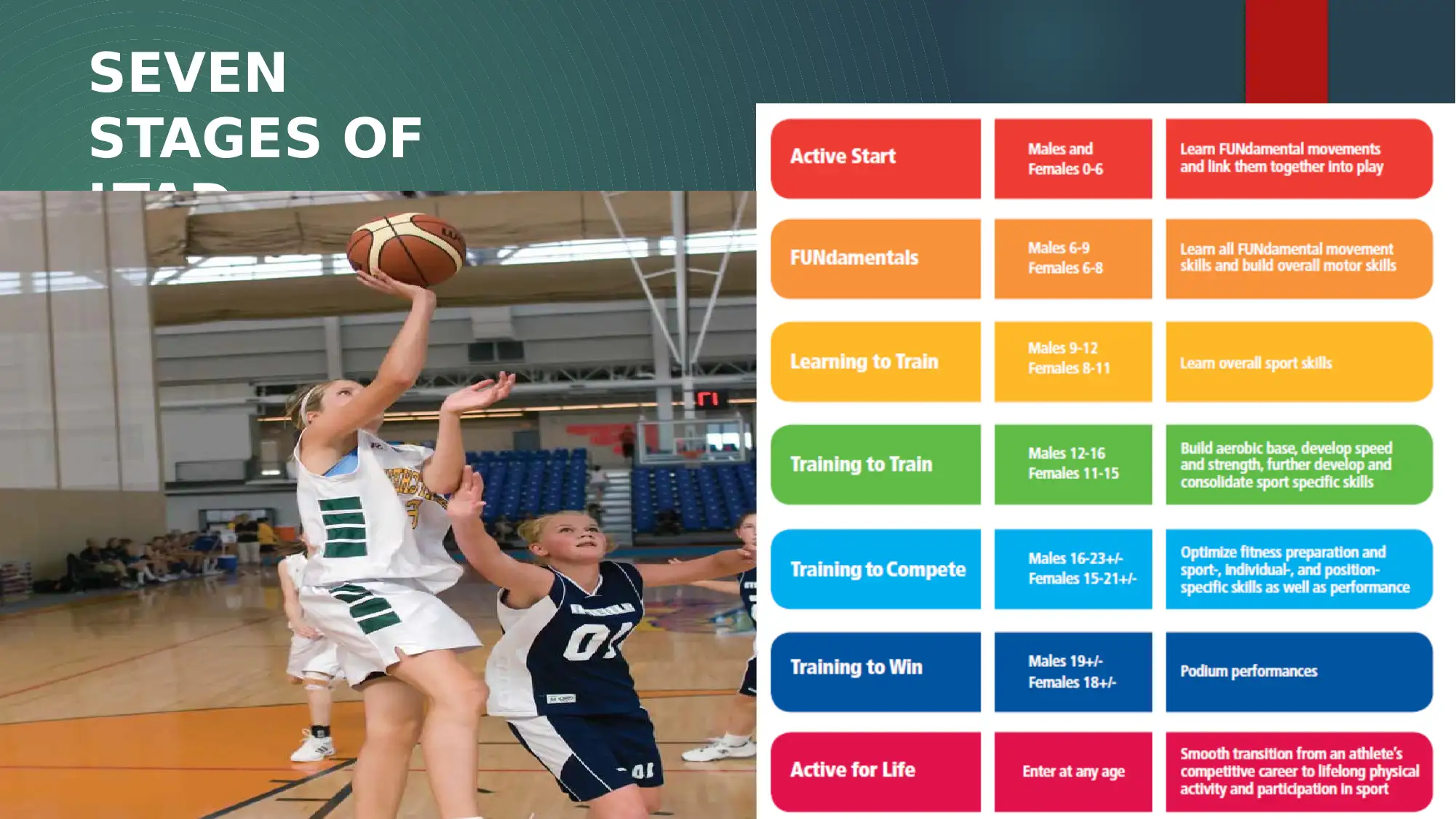
SEVEN
STAGES OF
LTAD
STAGES OF
LTAD
⊘ This is a preview!⊘
Do you want full access?
Subscribe today to unlock all pages.

Trusted by 1+ million students worldwide
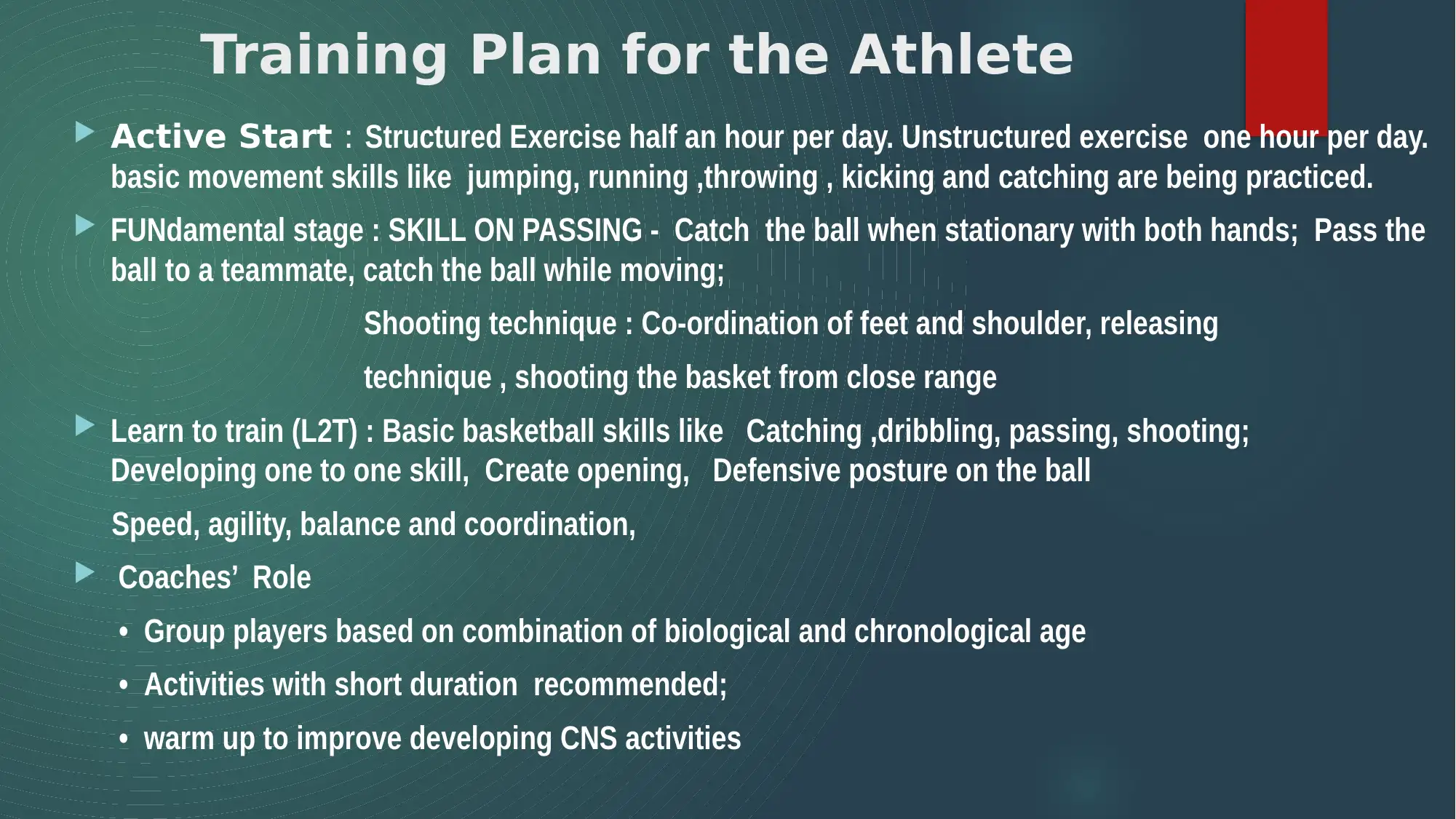
Training Plan for the Athlete
Active Start : Structured Exercise half an hour per day. Unstructured exercise one hour per day.
basic movement skills like jumping, running ,throwing , kicking and catching are being practiced.
FUNdamental stage : SKILL ON PASSING - Catch the ball when stationary with both hands; Pass the
ball to a teammate, catch the ball while moving;
Shooting technique : Co-ordination of feet and shoulder, releasing
technique , shooting the basket from close range
Learn to train (L2T) : Basic basketball skills like Catching ,dribbling, passing, shooting;
Developing one to one skill, Create opening, Defensive posture on the ball
Speed, agility, balance and coordination,
Coaches’ Role
• Group players based on combination of biological and chronological age
• Activities with short duration recommended;
• warm up to improve developing CNS activities
Active Start : Structured Exercise half an hour per day. Unstructured exercise one hour per day.
basic movement skills like jumping, running ,throwing , kicking and catching are being practiced.
FUNdamental stage : SKILL ON PASSING - Catch the ball when stationary with both hands; Pass the
ball to a teammate, catch the ball while moving;
Shooting technique : Co-ordination of feet and shoulder, releasing
technique , shooting the basket from close range
Learn to train (L2T) : Basic basketball skills like Catching ,dribbling, passing, shooting;
Developing one to one skill, Create opening, Defensive posture on the ball
Speed, agility, balance and coordination,
Coaches’ Role
• Group players based on combination of biological and chronological age
• Activities with short duration recommended;
• warm up to improve developing CNS activities
Paraphrase This Document
Need a fresh take? Get an instant paraphrase of this document with our AI Paraphraser
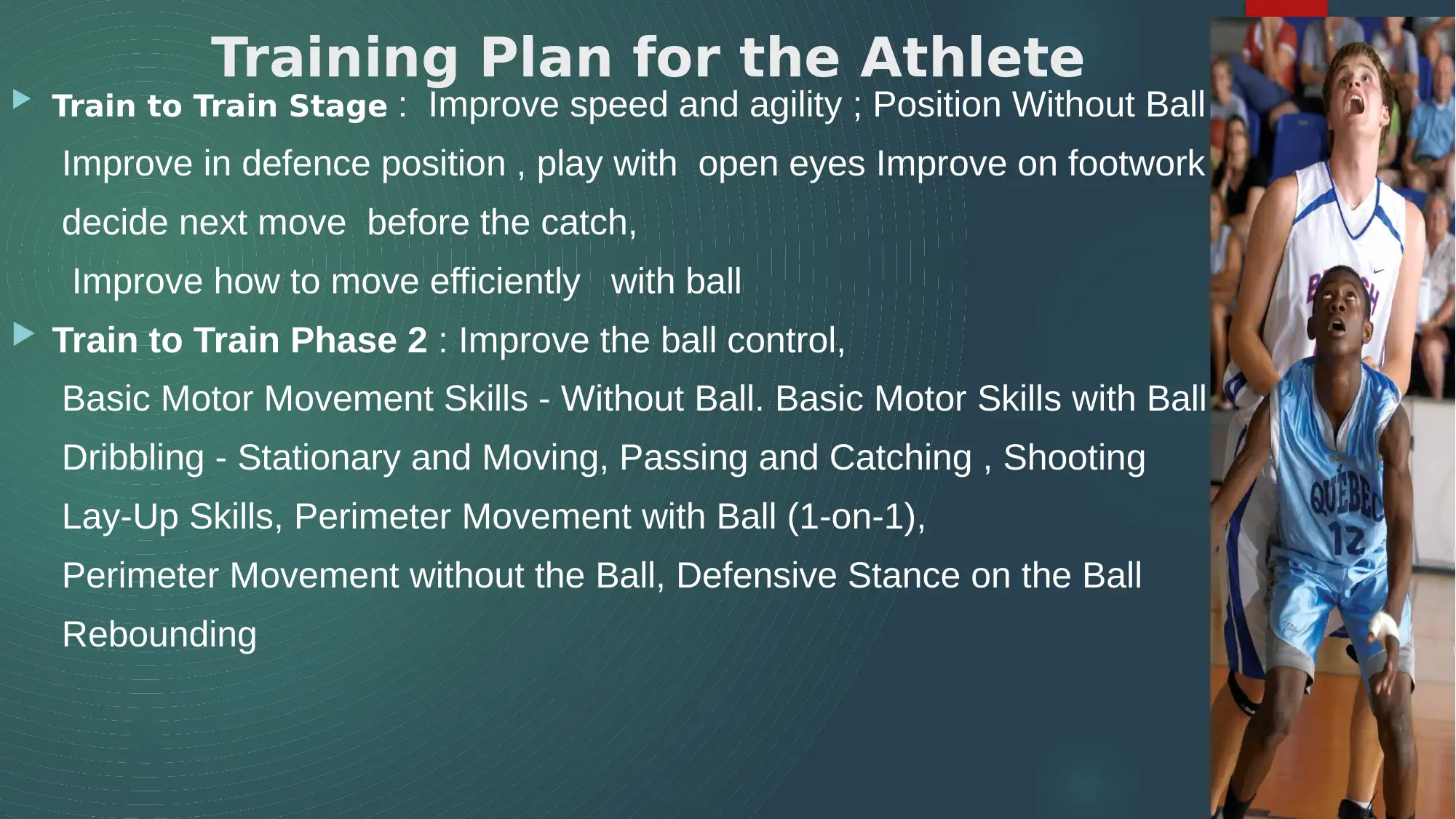
Training Plan for the Athlete
Train to Train Stage : Improve speed and agility ; Position Without Ball
Improve in defence position , play with open eyes Improve on footwork
decide next move before the catch,
Improve how to move efficiently with ball
Train to Train Phase 2 : Improve the ball control,
Basic Motor Movement Skills - Without Ball. Basic Motor Skills with Ball ,
Dribbling - Stationary and Moving, Passing and Catching , Shooting
Lay-Up Skills, Perimeter Movement with Ball (1-on-1),
Perimeter Movement without the Ball, Defensive Stance on the Ball
Rebounding
Train to Train Stage : Improve speed and agility ; Position Without Ball
Improve in defence position , play with open eyes Improve on footwork
decide next move before the catch,
Improve how to move efficiently with ball
Train to Train Phase 2 : Improve the ball control,
Basic Motor Movement Skills - Without Ball. Basic Motor Skills with Ball ,
Dribbling - Stationary and Moving, Passing and Catching , Shooting
Lay-Up Skills, Perimeter Movement with Ball (1-on-1),
Perimeter Movement without the Ball, Defensive Stance on the Ball
Rebounding
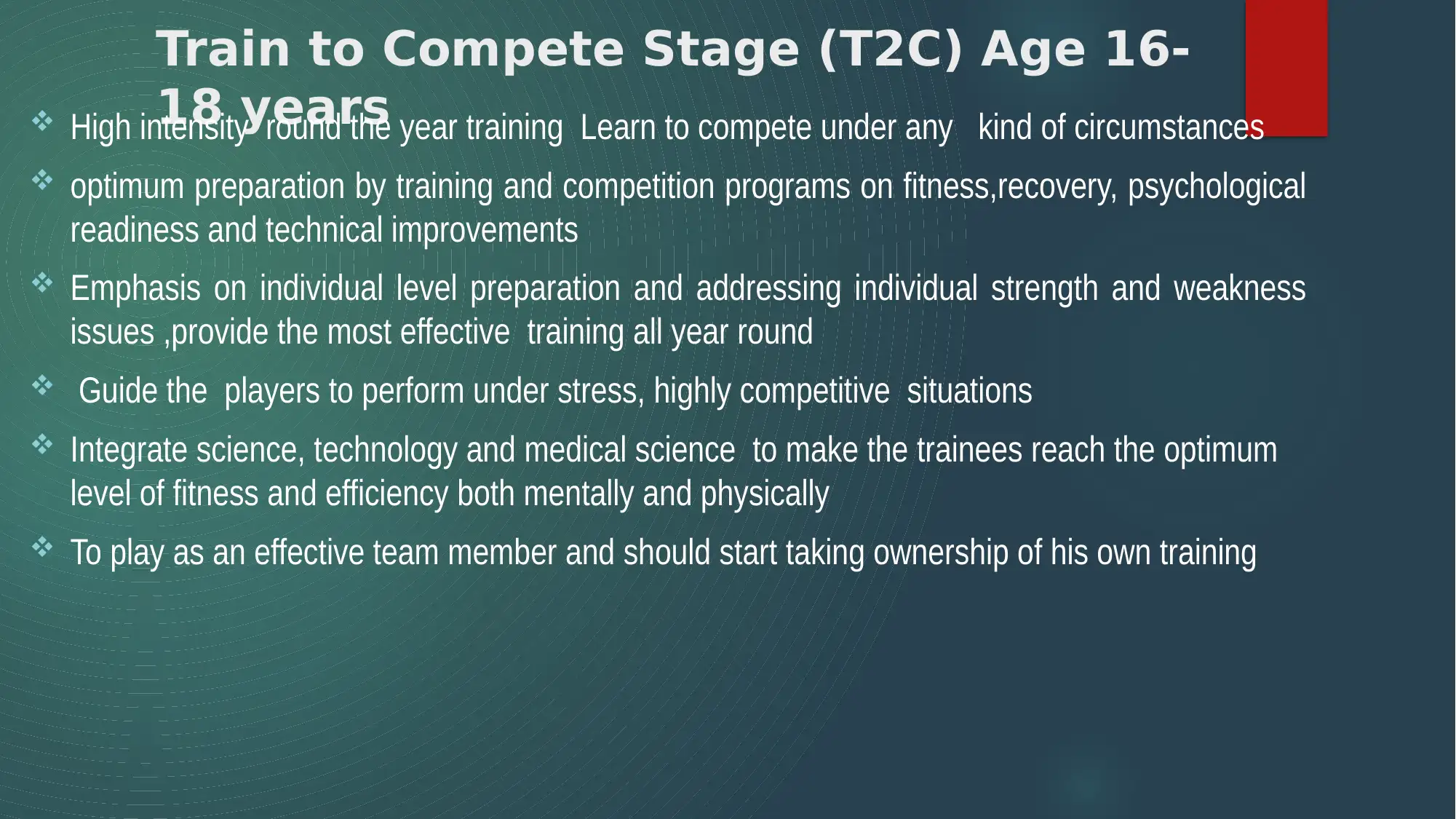
Train to Compete Stage (T2C) Age 16-
18 years High intensity round the year training Learn to compete under any kind of circumstances
optimum preparation by training and competition programs on fitness,recovery, psychological
readiness and technical improvements
Emphasis on individual level preparation and addressing individual strength and weakness
issues ,provide the most effective training all year round
Guide the players to perform under stress, highly competitive situations
Integrate science, technology and medical science to make the trainees reach the optimum
level of fitness and efficiency both mentally and physically
To play as an effective team member and should start taking ownership of his own training
18 years High intensity round the year training Learn to compete under any kind of circumstances
optimum preparation by training and competition programs on fitness,recovery, psychological
readiness and technical improvements
Emphasis on individual level preparation and addressing individual strength and weakness
issues ,provide the most effective training all year round
Guide the players to perform under stress, highly competitive situations
Integrate science, technology and medical science to make the trainees reach the optimum
level of fitness and efficiency both mentally and physically
To play as an effective team member and should start taking ownership of his own training
⊘ This is a preview!⊘
Do you want full access?
Subscribe today to unlock all pages.

Trusted by 1+ million students worldwide
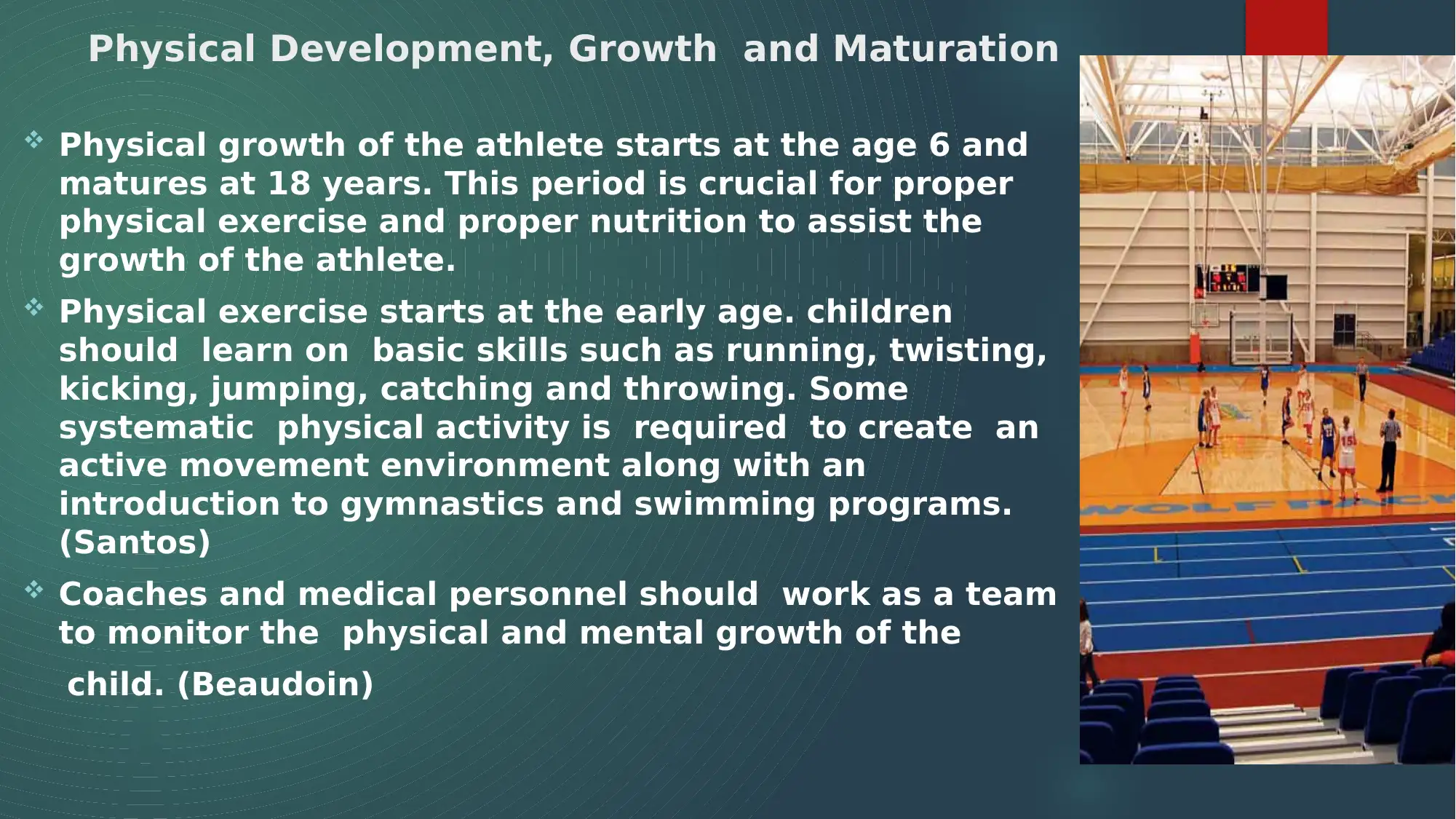
Physical Development, Growth and Maturation
Physical growth of the athlete starts at the age 6 and
matures at 18 years. This period is crucial for proper
physical exercise and proper nutrition to assist the
growth of the athlete.
Physical exercise starts at the early age. children
should learn on basic skills such as running, twisting,
kicking, jumping, catching and throwing. Some
systematic physical activity is required to create an
active movement environment along with an
introduction to gymnastics and swimming programs.
(Santos)
Coaches and medical personnel should work as a team
to monitor the physical and mental growth of the
child. (Beaudoin)
Physical growth of the athlete starts at the age 6 and
matures at 18 years. This period is crucial for proper
physical exercise and proper nutrition to assist the
growth of the athlete.
Physical exercise starts at the early age. children
should learn on basic skills such as running, twisting,
kicking, jumping, catching and throwing. Some
systematic physical activity is required to create an
active movement environment along with an
introduction to gymnastics and swimming programs.
(Santos)
Coaches and medical personnel should work as a team
to monitor the physical and mental growth of the
child. (Beaudoin)
Paraphrase This Document
Need a fresh take? Get an instant paraphrase of this document with our AI Paraphraser
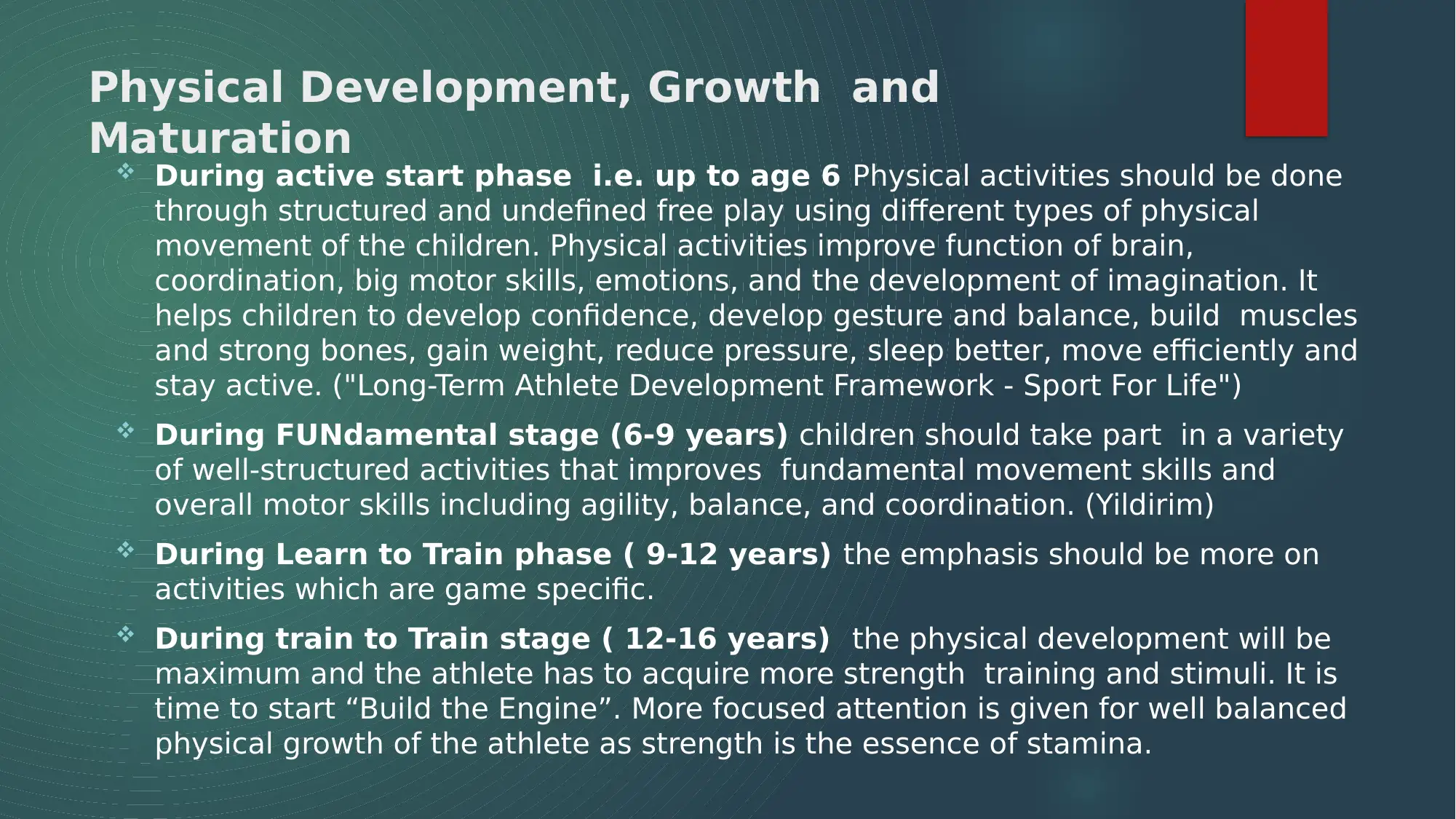
Physical Development, Growth and
Maturation
During active start phase i.e. up to age 6 Physical activities should be done
through structured and undefined free play using different types of physical
movement of the children. Physical activities improve function of brain,
coordination, big motor skills, emotions, and the development of imagination. It
helps children to develop confidence, develop gesture and balance, build muscles
and strong bones, gain weight, reduce pressure, sleep better, move efficiently and
stay active. ("Long-Term Athlete Development Framework - Sport For Life")
During FUNdamental stage (6-9 years) children should take part in a variety
of well-structured activities that improves fundamental movement skills and
overall motor skills including agility, balance, and coordination. (Yildirim)
During Learn to Train phase ( 9-12 years) the emphasis should be more on
activities which are game specific.
During train to Train stage ( 12-16 years) the physical development will be
maximum and the athlete has to acquire more strength training and stimuli. It is
time to start “Build the Engine”. More focused attention is given for well balanced
physical growth of the athlete as strength is the essence of stamina.
Maturation
During active start phase i.e. up to age 6 Physical activities should be done
through structured and undefined free play using different types of physical
movement of the children. Physical activities improve function of brain,
coordination, big motor skills, emotions, and the development of imagination. It
helps children to develop confidence, develop gesture and balance, build muscles
and strong bones, gain weight, reduce pressure, sleep better, move efficiently and
stay active. ("Long-Term Athlete Development Framework - Sport For Life")
During FUNdamental stage (6-9 years) children should take part in a variety
of well-structured activities that improves fundamental movement skills and
overall motor skills including agility, balance, and coordination. (Yildirim)
During Learn to Train phase ( 9-12 years) the emphasis should be more on
activities which are game specific.
During train to Train stage ( 12-16 years) the physical development will be
maximum and the athlete has to acquire more strength training and stimuli. It is
time to start “Build the Engine”. More focused attention is given for well balanced
physical growth of the athlete as strength is the essence of stamina.
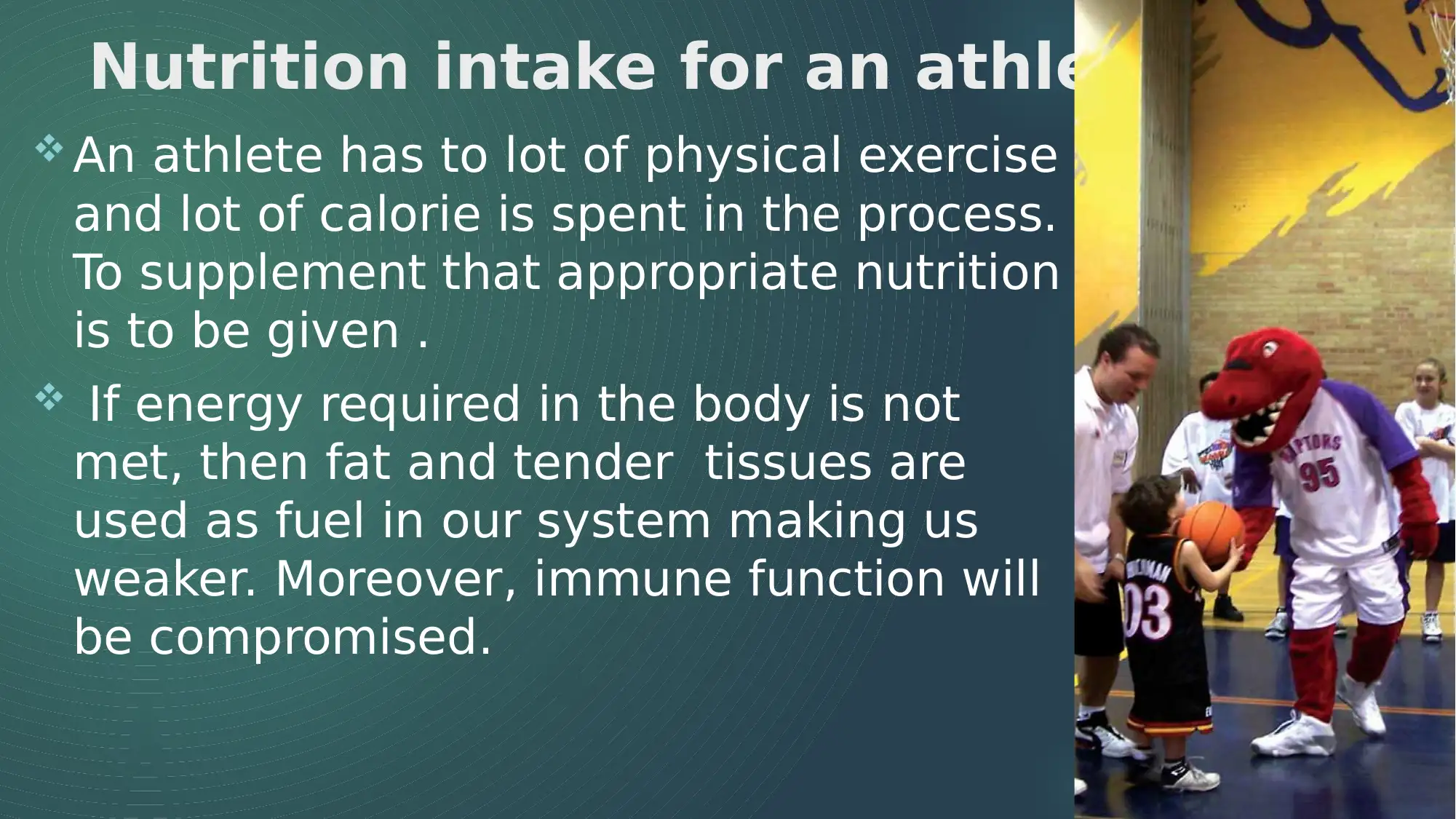
Nutrition intake for an athlete
An athlete has to lot of physical exercise
and lot of calorie is spent in the process.
To supplement that appropriate nutrition
is to be given .
If energy required in the body is not
met, then fat and tender tissues are
used as fuel in our system making us
weaker. Moreover, immune function will
be compromised.
An athlete has to lot of physical exercise
and lot of calorie is spent in the process.
To supplement that appropriate nutrition
is to be given .
If energy required in the body is not
met, then fat and tender tissues are
used as fuel in our system making us
weaker. Moreover, immune function will
be compromised.
⊘ This is a preview!⊘
Do you want full access?
Subscribe today to unlock all pages.

Trusted by 1+ million students worldwide
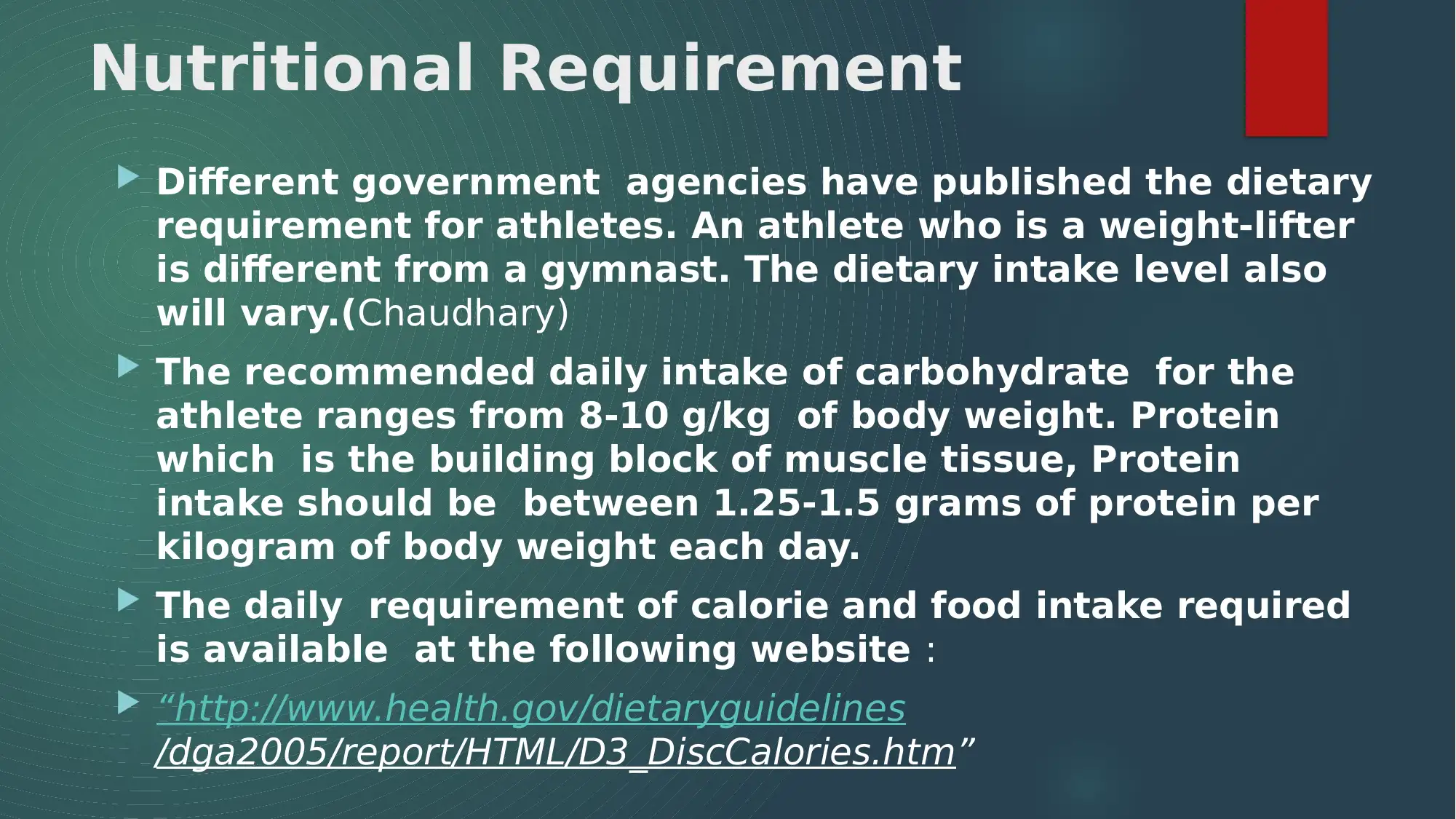
Nutritional Requirement
Different government agencies have published the dietary
requirement for athletes. An athlete who is a weight-lifter
is different from a gymnast. The dietary intake level also
will vary.(Chaudhary)
The recommended daily intake of carbohydrate for the
athlete ranges from 8-10 g/kg of body weight. Protein
which is the building block of muscle tissue, Protein
intake should be between 1.25-1.5 grams of protein per
kilogram of body weight each day.
The daily requirement of calorie and food intake required
is available at the following website :
“http://www.health.gov/dietaryguidelines
/dga2005/report/HTML/D3_DiscCalories.htm”
Different government agencies have published the dietary
requirement for athletes. An athlete who is a weight-lifter
is different from a gymnast. The dietary intake level also
will vary.(Chaudhary)
The recommended daily intake of carbohydrate for the
athlete ranges from 8-10 g/kg of body weight. Protein
which is the building block of muscle tissue, Protein
intake should be between 1.25-1.5 grams of protein per
kilogram of body weight each day.
The daily requirement of calorie and food intake required
is available at the following website :
“http://www.health.gov/dietaryguidelines
/dga2005/report/HTML/D3_DiscCalories.htm”
Paraphrase This Document
Need a fresh take? Get an instant paraphrase of this document with our AI Paraphraser
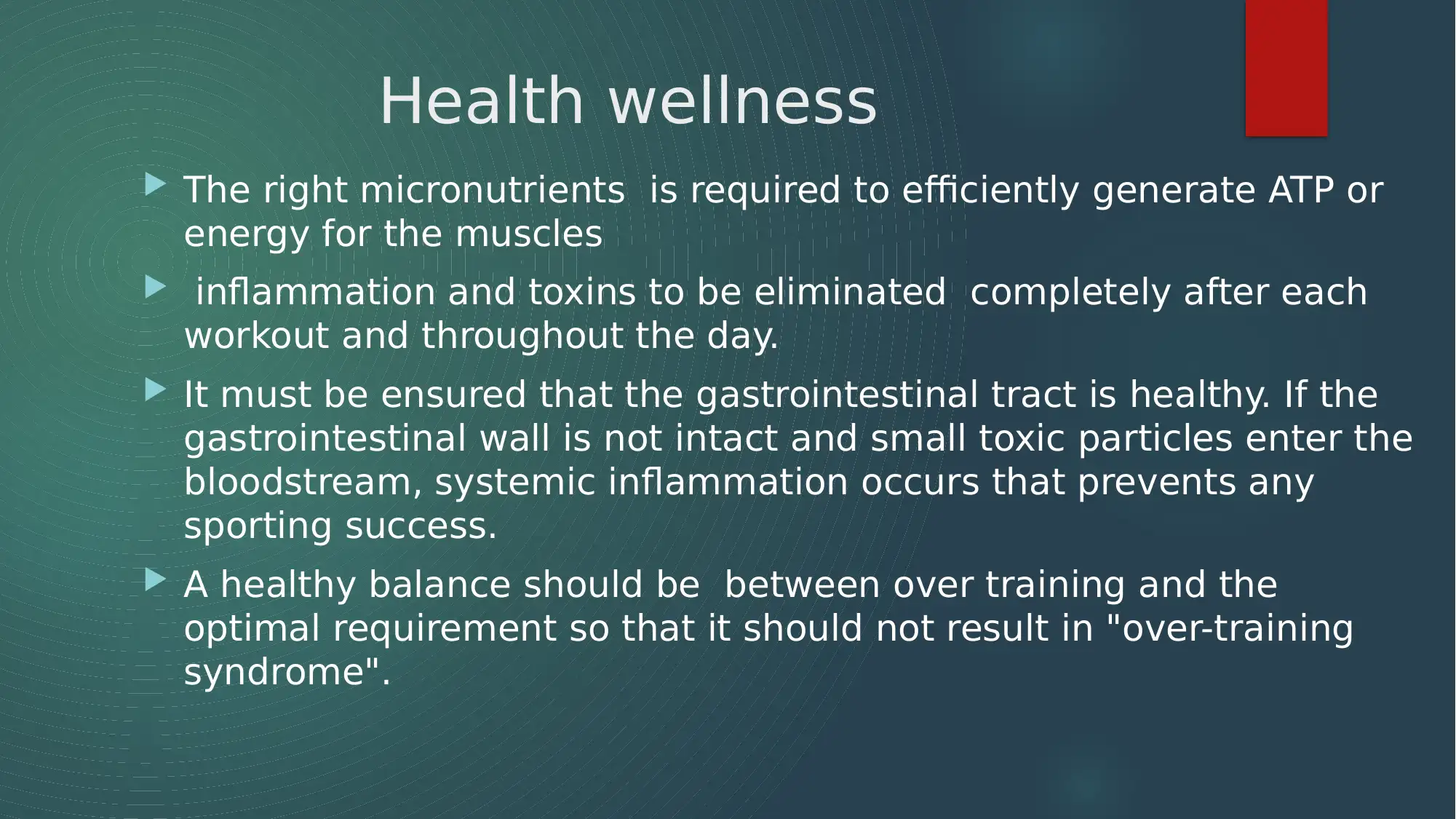
Health wellness
The right micronutrients is required to efficiently generate ATP or
energy for the muscles
inflammation and toxins to be eliminated completely after each
workout and throughout the day.
It must be ensured that the gastrointestinal tract is healthy. If the
gastrointestinal wall is not intact and small toxic particles enter the
bloodstream, systemic inflammation occurs that prevents any
sporting success.
A healthy balance should be between over training and the
optimal requirement so that it should not result in "over-training
syndrome".
The right micronutrients is required to efficiently generate ATP or
energy for the muscles
inflammation and toxins to be eliminated completely after each
workout and throughout the day.
It must be ensured that the gastrointestinal tract is healthy. If the
gastrointestinal wall is not intact and small toxic particles enter the
bloodstream, systemic inflammation occurs that prevents any
sporting success.
A healthy balance should be between over training and the
optimal requirement so that it should not result in "over-training
syndrome".
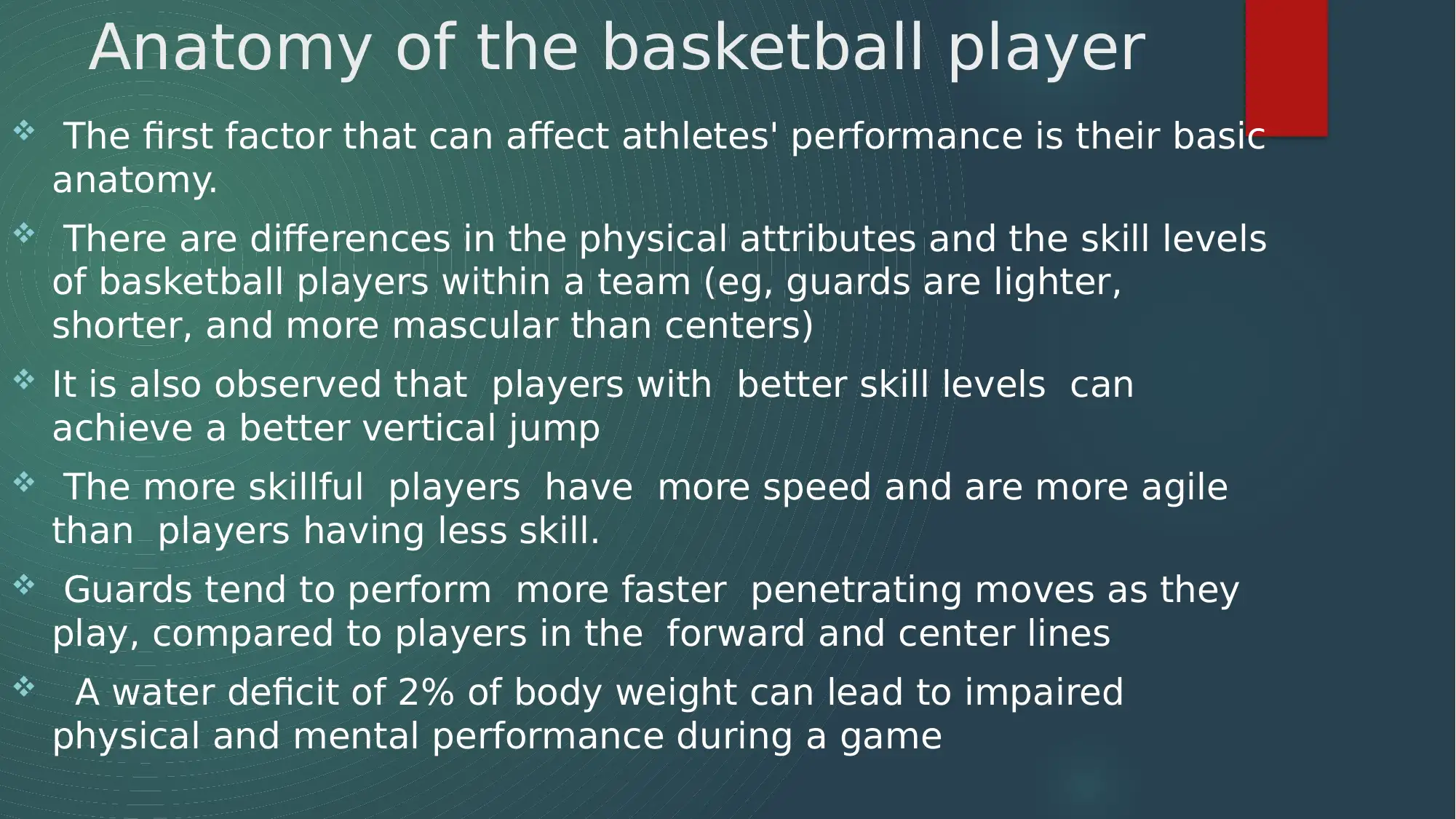
Anatomy of the basketball player
The first factor that can affect athletes' performance is their basic
anatomy.
There are differences in the physical attributes and the skill levels
of basketball players within a team (eg, guards are lighter,
shorter, and more mascular than centers)
It is also observed that players with better skill levels can
achieve a better vertical jump
The more skillful players have more speed and are more agile
than players having less skill.
Guards tend to perform more faster penetrating moves as they
play, compared to players in the forward and center lines
A water deficit of 2% of body weight can lead to impaired
physical and mental performance during a game
The first factor that can affect athletes' performance is their basic
anatomy.
There are differences in the physical attributes and the skill levels
of basketball players within a team (eg, guards are lighter,
shorter, and more mascular than centers)
It is also observed that players with better skill levels can
achieve a better vertical jump
The more skillful players have more speed and are more agile
than players having less skill.
Guards tend to perform more faster penetrating moves as they
play, compared to players in the forward and center lines
A water deficit of 2% of body weight can lead to impaired
physical and mental performance during a game
⊘ This is a preview!⊘
Do you want full access?
Subscribe today to unlock all pages.

Trusted by 1+ million students worldwide
1 out of 14
Your All-in-One AI-Powered Toolkit for Academic Success.
+13062052269
info@desklib.com
Available 24*7 on WhatsApp / Email
![[object Object]](/_next/static/media/star-bottom.7253800d.svg)
Unlock your academic potential
Copyright © 2020–2025 A2Z Services. All Rights Reserved. Developed and managed by ZUCOL.

